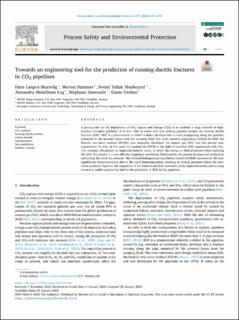| dc.contributor.author | Skarsvåg, Hans Langva | |
| dc.contributor.author | Hammer, Morten | |
| dc.contributor.author | Munkejord, Svend Tollak | |
| dc.contributor.author | Log, Alexandra Metallinou | |
| dc.contributor.author | Dumoulin, Stephane | |
| dc.contributor.author | Gruben, Gaute | |
| dc.date.accessioned | 2023-09-26T10:34:04Z | |
| dc.date.available | 2023-09-26T10:34:04Z | |
| dc.date.created | 2023-01-27T11:15:22Z | |
| dc.date.issued | 2023 | |
| dc.identifier.citation | Process Safety and Environmental Protection (PSEP). 2023, 171 667-679. | en_US |
| dc.identifier.issn | 0957-5820 | |
| dc.identifier.uri | https://hdl.handle.net/11250/3092006 | |
| dc.description.abstract | A prerequisite for the deployment of CO2 capture and storage (CCS) is to establish a large network of high-pressure transport pipelines. It is then vital to assess new and existing pipeline designs for running ductile fracture (RDF). RDF is a phenomenon in which a defect develops into a crack propagating along the pipeline, sustained by the pressure forces from the escaping fluid. The most common engineering method for RDF, the Battelle two-curve method (BTCM), was originally developed for natural gas (NG) and has proved non-conservative for CO2. In this work we examine the BTCM in the light of available RDF experiments with CO2-rich mixtures. We present an improved material curve, in which the change in fluid properties when replacing NG with CO2 results in a new effective toughness correlation. Furthermore, we present an improved method for calculating the crack-tip pressure. This delayed homogeneous equilibrium model (D-HEM) accounts for the non-equilibrium thermodynamics due to the rapid depressurization, resulting in boiling pressures below the saturation pressure. Together, the adaptation of the material and fluid treatment yields improved results, and is a step towards a viable engineering tool for the prediction of RDF in CO2 pipelines. | en_US |
| dc.description.abstract | Towards an engineering tool for the prediction of running ductile fractures in CO2 pipelines | en_US |
| dc.language.iso | eng | en_US |
| dc.publisher | Elsevier | en_US |
| dc.rights | Navngivelse 4.0 Internasjonal | * |
| dc.rights.uri | http://creativecommons.org/licenses/by/4.0/deed.no | * |
| dc.title | Towards an engineering tool for the prediction of running ductile fractures in CO2 pipelines | en_US |
| dc.title.alternative | Towards an engineering tool for the prediction of running ductile fractures in CO2 pipelines | en_US |
| dc.type | Peer reviewed | en_US |
| dc.type | Journal article | en_US |
| dc.description.version | publishedVersion | en_US |
| dc.source.pagenumber | 667-679 | en_US |
| dc.source.volume | 171 | en_US |
| dc.source.journal | Process Safety and Environmental Protection (PSEP) | en_US |
| dc.identifier.doi | 10.1016/j.psep.2023.01.054 | |
| dc.identifier.cristin | 2116343 | |
| dc.relation.project | Norges forskningsråd: 257579 | en_US |
| cristin.ispublished | true | |
| cristin.fulltext | original | |
| cristin.qualitycode | 1 | |

